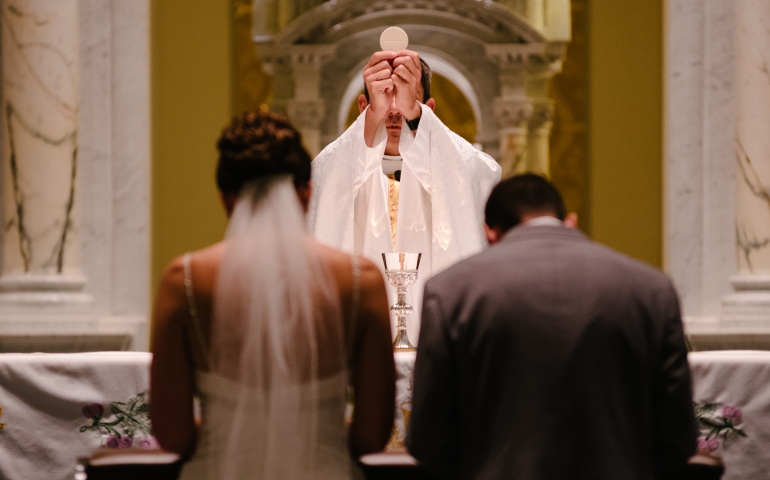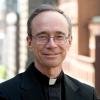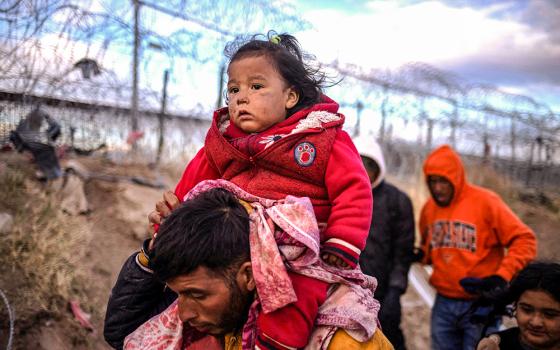
Unsplash/Josh Applegate
It is time for the Catholic bishops to stop hoping for an increase in vocations to the celibate priesthood and to acknowledge that the church needs married priests to serve the people of God. We cannot have a Catholic Church without sacraments, and a priest is needed for the Eucharist, confession, and anointing.
At the Last Supper, Jesus said, "Do this in memory of me," not, "Have a celibate priesthood." The need for the Eucharist trumps having a celibate priesthood.
For at least 50 years, the Catholic Church in the United States has seen a drop in the number of priests. According to Center for Applied Research in the Apostolate reports, in 1970, there were 59,192 priests in the U.S.; by 2016, there were only 37,192. Meanwhile, the number of Catholics increased to 74.2 million from 51 million. That means the people-priest ratio grew from 861 Catholics per priest in 1970 to 1,995 per priest in 2016. These numbers include all priests both religious and diocesan, as well as retired priests. When the priests currently over 65 years of age die, these numbers will be even worse.
Already, in many parts of the United States, we have seen the impact of declining numbers of priests. Parishes are merging and closing. Few parishes have more than one priest. African and Asian priests have become missionaries to the United States. In rural areas, priests drive hundreds of miles on weekends visiting parishes in small towns that no longer have a resident priest. Some rural parishes might see a priest once a month. The number of priestless parishes rose from 571 in 1970 to 3,499 in 2016.
The problem is not just in the United States; in fact, it is worse elsewhere. In 2014, there were 414,313 priests for 1.2 billion Catholics in the world, for a Catholics-priest ratio of 2,896 to one.
In Latin America, for historical reasons, there has been a shortage of priests for more than 100 years. This is one of the reasons that evangelicals and Pentecostals have been successful in Latin America. If there is no priest in the town, people will go wherever there is a service.
Africa and Asia are pointed to as places where vocations are plentiful, but even in those areas, there are not enough priests. And already, vocations are beginning to fall in some places on those continents.
Why are vocations declining?
There are lots of theories. Conservatives tend to blame secular culture and the current generation of young people who are seen as self-centered consumers who lack the discipline and spirit of self-sacrifice necessary to be priests.
Sociologists point to demographic changes. Families are smaller. In a large family, parents support having one of their children become a priest, but if they have only one or two children, parents prefer grandchildren to priests.
Universal access to education also makes a difference. Historically, becoming a priest was one of the few ways to get an education, especially for a child not from a rich family. The priest was often the best-educated person in the community, which gave him additional status. Today education is more readily available. The priest does not have the status he had in the past.
In brief, a lot of vocations in the past came from large families where the priest was the first member of the family to get a college education and where the family lived in a community where the parish priest was a respected figure. As this world disappears, so do vocations. Even in parts of India, where Catholics are educated, middle-class and having fewer children, we see a decline in vocations already.
There is nothing to indicate that this will not continue to happen in Africa and Asia when Catholics become more prosperous.
There have also been changes in the church that have affected vocations. The Second Vatican Council stressed the role of the laity and the importance of marriage as a path to holiness. Priesthood and religious life were taken off their pedestals.
Also, after the council, many ministries that previously were open only to priests became possible for laypeople. There are now lay theologians, pastoral ministers, spiritual directors, teachers, as well as laypeople working in chanceries and Catholic charities. Technically, a layperson can do almost anything a priest can except preside at the Eucharist, hear confessions and anoint the sick. Those who felt called to serve the church saw that they could marry and do many things without being a priest.
American sociologist Dean Hoge surveyed young men working in campus ministry and found that significant numbers would be interested in being priests if they could marry. In fact, some argue that there has not been a decline in vocations; the bishops are simply not acknowledging that God is calling married men and even women to the priesthood.
Earlier this month, Pope Francis spoke about vocations and the possibility of ordaining viri probati, that is proven or tested married men.
"The problem is the lack of vocations, a problem the church must solve," Francis said. "We must think about whether viri probati are one possibility, but that also means discussing what tasks they could take on in remote communities. In many communities at the moment, committed women are preserving Sunday as a day of worship by holding services of the Word. But a church without the Eucharist has no strength."
In my column last week, I noted that one of the major achievements of Francis is his opening up debate and discussion in the church. Although Pope Paul VI briefly considered the idea, discussing married priests was not permitted under the last two papacies. I could not have written this column when I was editor of America magazine (1998-2005).
Even as an archbishop, Jorge Bergoglio was gently raising the issue of married priests. In Chapter 6 of On Heaven and Earth, he acknowledged that there were already married priests in the Catholic Church from the Eastern traditions (Byzantine, Ukrainian or Greek), and he noted that they were good priests. The Western or Roman Catholic Church has the rule of celibacy, but the Eastern Catholic Churches, who are in union with Rome, have always had married priests. In the United States, we also have former Anglican and Lutheran priests who are married and operating as priests in the Catholic Church today.
For about the first 1,000 years of its existence, the church had married clergy. For the last 1,000 years, we have had the rule of celibacy. The rule is not always well observed. Bergoglio hated the practice of priests not living up to their commitment. He could be forgiving if the priest changed his ways, but he said he preferred a good layman to a bad priest. If a priest fathered a child, Bergoglio said the priest must leave because a child’s right to have a father was greater than a man’s obligation to remain a priest.
I believe that Francis is in favor of optional celibacy, but he is not going to suddenly announce from St. Peter’s Square that the church is going to have married priests beginning next week. That is not the way he operates. He believes in a collegial church where he makes decisions along with the college of bishops.
Erwin Krautler, a Brazilian bishop, approached the pope about having married priests in his huge diocese in the Amazon rainforest where there are 700,000 Catholics and 27 priests. The pope’s response was to urge him to go back to his bishops’ conference and get the bishops to ask for it. This is the most likely way that married priests will be reintroduced in to the Roman branch of the Catholic Church. It will be at the request of bishops’ conferences for married priests in remote places where there is great need. But once married priests are introduced, they will spread quickly to other places.
If the people of God want married priests, they need to let their bishops know. The pope is waiting for the bishops to ask. People need to push their bishops to ask.
[Jesuit Fr. Thomas Reese is a senior analyst for NCR and author of Inside the Vatican: The Politics and Organization of the Catholic Church. His email address is treesesj@ncronline.org.]
Editor's note: We can send you an email alert every time Thomas Reese's column, Faith and Justice, is posted. Go to this page and follow directions: Email alert sign-up.




